Page Table of Contents
About the Author
Hot Topics
Updated on Dec 23, 2025
| Workable Solutions | Step-by-step Troubleshooting |
|---|---|
| Method 1. Restore SD card full size with EaseUS partitioning tool | (Partition Master) Step 1: Launch EaseUS Partition Master, right-click the partition on your external hard drive/USB/SD...Full steps |
| Method 2. Repair SD card showing less space via Command Prompt | Step 1: In Windows 10, for example, type cmd in the search box, you can get the best match called Command Prompt....Full steps |
| Method 3. Repair SD card showing less capacity via Disk Management | Step 1: Press Windows+R > Choose Disk Management; Step 2: Right-click SD card and select Format....Full steps |
Reasons for SD Card Not Showing Full Capacity
Similar cases can happen on other storage devices like USB flash drive, pen drive, hard drive, memory card, etc. Why is my SD card not showing its full capacity? How can I restore the SD memory card to the full size? Users always ask questions when they encountered such strange events.
Usually, SD card not showing full capacity happens because some card readers or host devices are not compatible with the larger SDHC and SDXC cards. If the reader or host is not compatible with the larger capacity, the card will be repartitioned to a size that is supported. For example, if your card reader or camera is compatible with an SDHC card with a maximum capacity of 32GB using this reader or camera to format a 64GB SDXC card will result in the card being repartitioned to 32GB (~27GB usable capacity). And SD card not showing full capacity can also occur due to invisible shadow files, formatting overhead, hidden recovery partitions, and unallocated space.
If you're experiencing similar issues to the SD card not showing full capacity, don't worry! Here is a solution. You can use a reader or host that supports the full capacity of the card and use a third-party SD card format tool to restore full capacity on SDHC/SDXC cards with ease. What's more, use the Diskpart command to repair it.
Extended Reading: SSD Reports Wrong Size
Method 1. Restore SD Card Full Size with EaseUS Partitioning Tool
To help you reclaim lost or unallocated space and restore SD card to full capacity/original size safely and easily, here we recommend you EaseUS Partition Master, a powerful disk management tool that allows you to format hard drives and conventional removable storage devices. Now you can try the following guide to reformat SD card and restore SD card to full capacity with this tool in simple steps.
- Notice:
- To avoid data loss when SD card not showing full capacity, we recommend backing up important files first. Read on how to backup sd card for data security.
Step 1. Launch EaseUS Partition Master, right-click the partition on your external hard drive/USB/SD card which you want to format and choose the "Format" option.
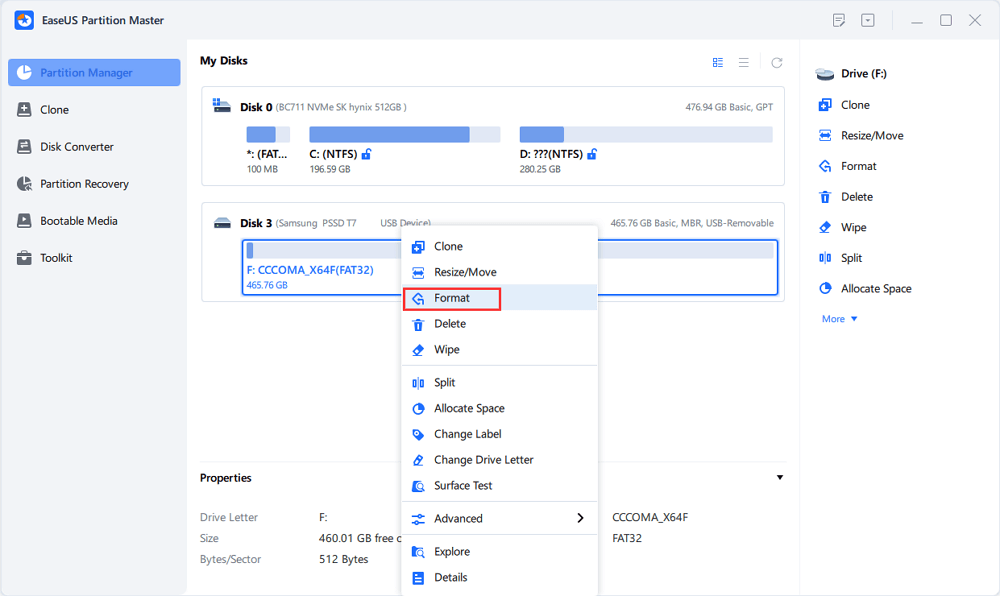
Step 2. Assign a new partition label, file system (NTFS/FAT32/EXT2/EXT3/EXT4/exFAT), and cluster size to the selected partition, then click "OK".
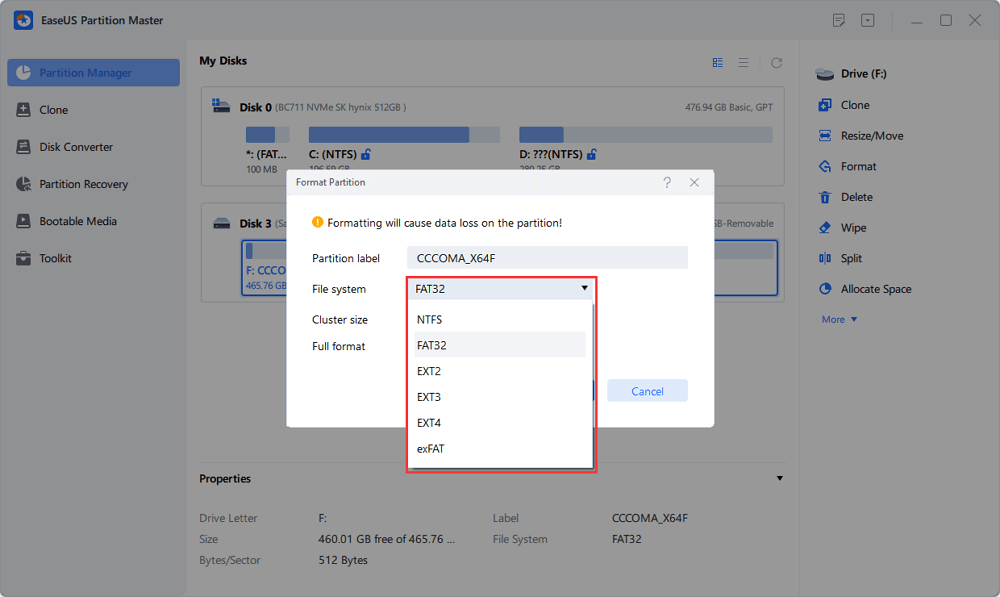
Step 3. In the Warning window, click "Yes" to continue.
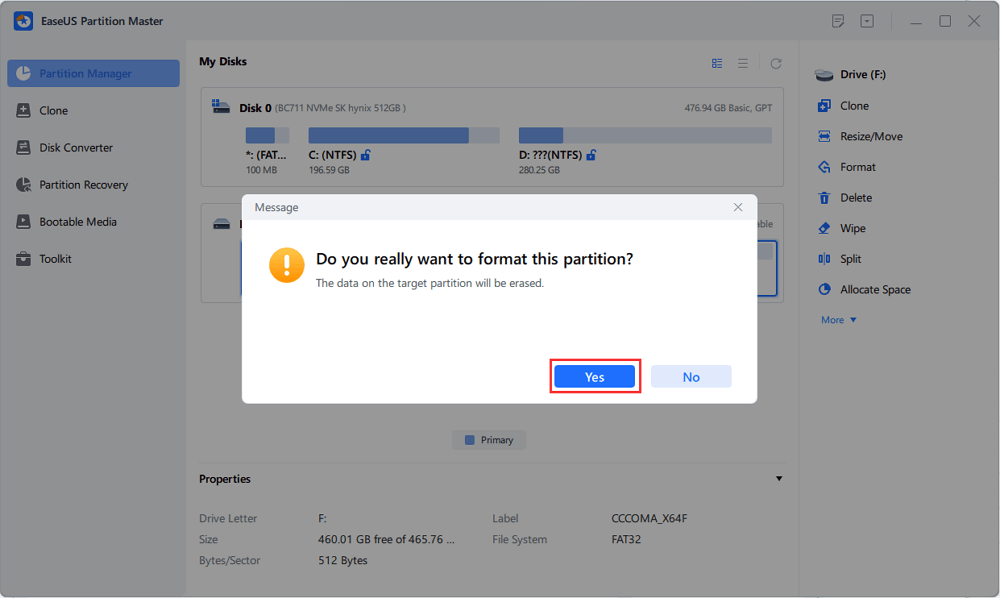
Step 4. Click the "Execute 1 Task(s)" button in the top-left corner to review the changes, then click "Apply" to start formatting your external hard drive/USB/SD card.
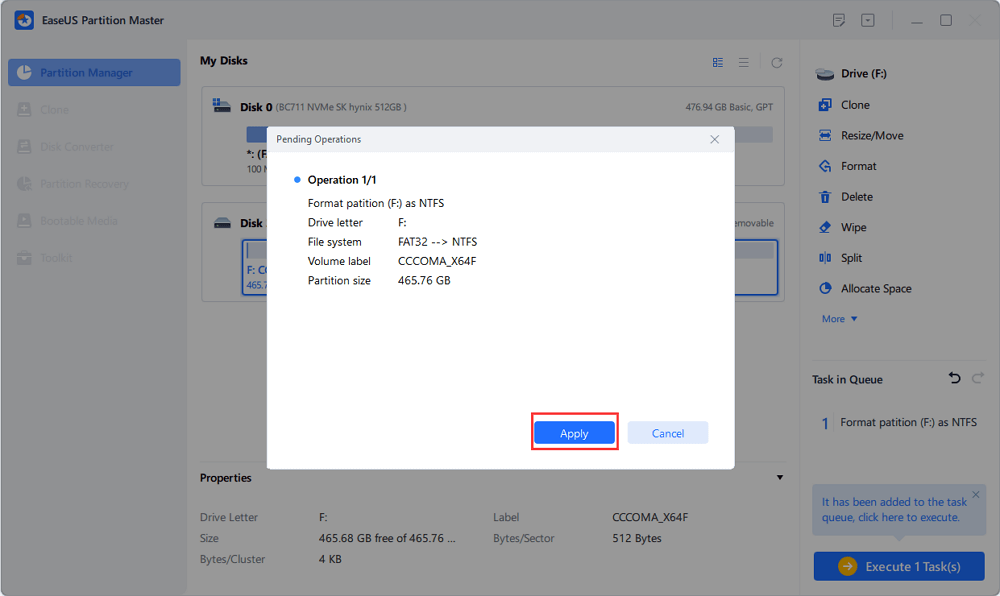
Additional tips for choosing a proper file system for your SD card:
- FAT32 – Suitable for 2-32GB memory card. (Optimal choice)
- NTFS – Suitable for almost all sizes of SD cards, under 2TB.
Method 2. Repair SD Card Showing Less Space via Command Prompt
The introduced SD card formatter shall hopefully help you regain the original size of the memory card. Though this is the easiest and most powerful way to deal with a removable hard disk that is showing less disk space than actual, there is still an alternative way to do this. Windows Command Prompt, which requires a higher level of computer skills than using the third-party automated tool, doesn't need to download and install. It's a built-in Windows native tool for everyone with administrator privilege to use.
To troubleshoot the SD card, of which some precious storage was lost somehow, you can use the DISKPART command lines to recreate a new volume by carefully following each step.
Step 1: In Windows 10, for example, type cmd in the search box, you can get the best match called Command Prompt. Right-click on it and choose "Run as administrator".
Step 2: On the Command Prompt black window, type diskpart and press "Enter".
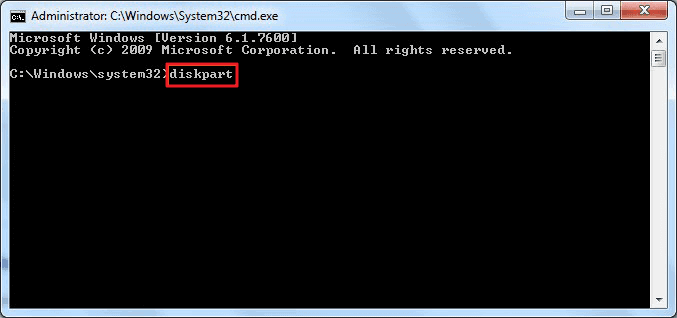
Step 3: Now type list disk and press "Enter". All the disk drives will be listed, including your SD card connected to the computer.
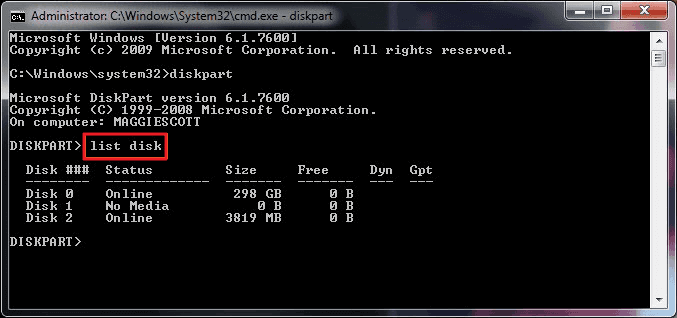
Step 4: Refer to the list disk information, type select disk + disk number, for example, select disk 2 and press enter. You're telling diskpart to format disk 2.
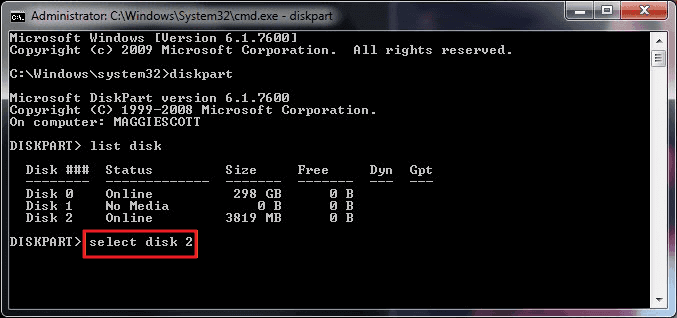
Step 5: Go on to type clean. This step starts to clean up all files and folders on the selected hard disk.
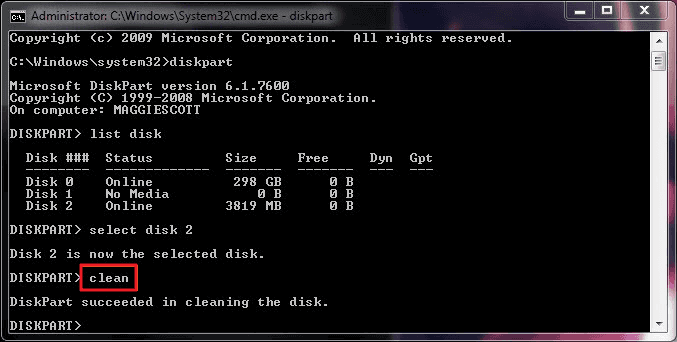
Step 6: Type create partition primary and press "Enter".
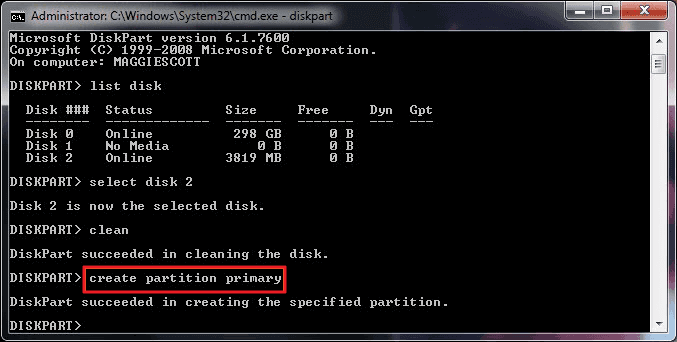
Step 7: After diskpart successfully created the specified partition, type format fs=ntfs (or format fs=exfat) and press "Enter". You're telling diskpart to format the drive with a file system, let it be NTFS, exFAT, etc.
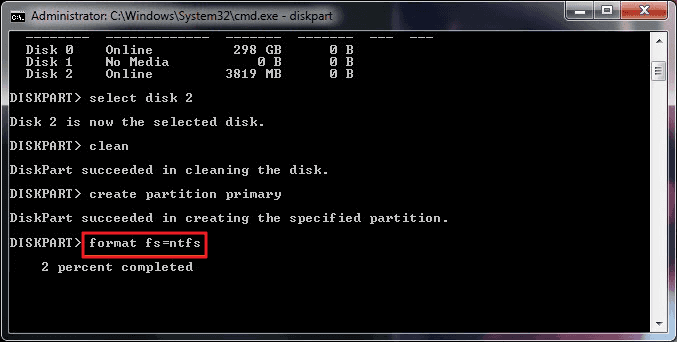
Step 8: At last, assign a drive letter to the newly created partition by typing assign.
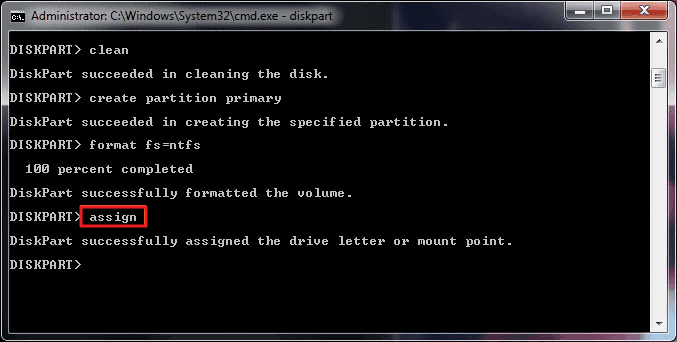
Additional tips for running Diskpart without a hitch:
- You must run Diskpart as administrators. Otherwise, Windows will forbid you to run it properly. There is another access to open Windows Command Prompt: Windows + X keys -> Command Prompt (Admin).
- Here's how to deal with the other common error: Diskpart has encountered an error access is denied.
Does this way help you repair the "SD card showing less capacity issue?" If it does, you can share this article to help more people facing the same problem.
Method 3. Repair SD Card Showing Less Capacity via Disk Management
In order to restore SD card to factory settings, please follow the steps of disk management:
Step 1. Press Windows+R > Choose Disk Management.
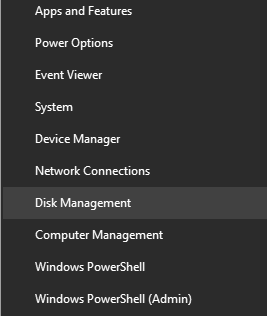
Step 2. Right-click SD card and select Format.
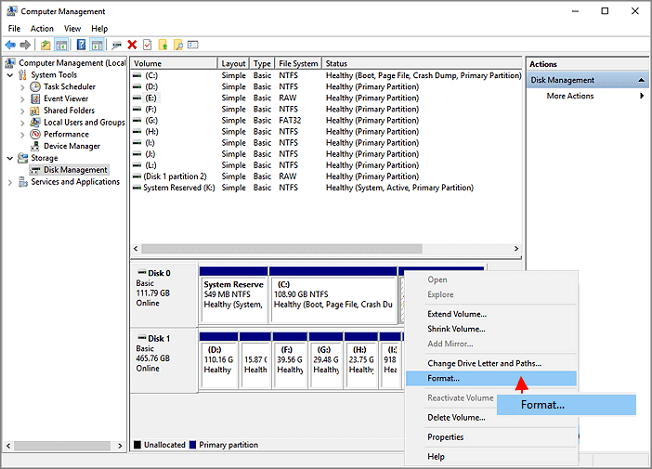
How to Restore SD Card to Full Capacity on Mac
When it comes to repair SD card showing less capacity, here is a guide about how to reset a SD card.
Step 1: Open Disk Utility app.
Step 2: Select your SD card and choose Erase.
Step 3: Choose file system > Erase.
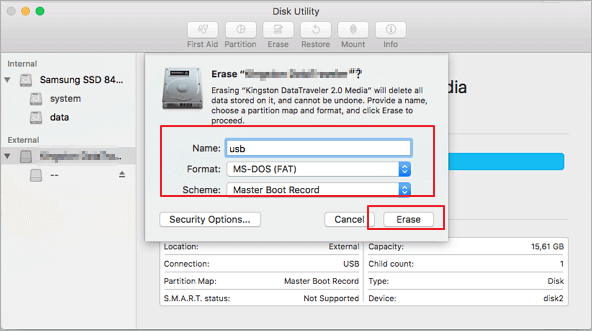
After this, your SD card will display its full storage capacity on the computer and you can save as many files as you want to the device by then.
🔥Explore More: Solved: Ender 3 Not Reading SD Card [Quick Fixes]
Conclusion
On this page, we introduced 4 reliable methods to assist you in resolving the SD card not showing full capacity issue on both Windows and Mac computers.
- On Windows computer, the best solution to resolve SD card not showing full size is to turn to EaseUS Partition Master for help.
- On Mac, the best tool to deal with SD card showing partial space error is to use Disk Utility to format and erase the drive to full capacity.
FAQS About SD Card Not Showing Full Capacity
If you have further questions bout this issue, follow the questions here and find the answers below:
1. How do I fix SD card not showing full capacity?
- Connect the SD card to your computer.
- Open File Explorer to locate SD card volume, open and back up all useful data from SD card to another drive.
- Right-click on SD card and select "Format".
- Tick "Perform a quick format" and set a new file system to the SD card.
- Click "Start" and "OK".
2. Why does my memory card show less capacity than listed?
The reason why a storage device or drive shows less than advertised is that storage drive capacity is calculated differently from then other capacities in computing. In a storage device, 1GB is regarded as 1000000000 bytes, while in computing 1GB is calculated as 1024MB = 1,048,576kb=1,073,741,824 bytes.
For example, here we'll take a 250GB memory card as an example to show you the differences:
- Memory card advertised capacity: 250GB
- Memory card Windows reported capacity: 233GB
This is why your memory card shows less capacity than listed.
3. Why does my 16GB SD card show 14GB?
The 16GB in the SD card is its storage capacity which is defined in bytes, while the 14GB that you see shown on the computer is its computing storage capacity which used GB to calculate the value. Also, 16GB storage capacity in a memory card equals 14.9GB on a computer, this is why you see a 16GB SD card shows only 14GB on a computer.
How Can We Help You
About the Author
Updated by Tracy King
Tracy became a member of the EaseUS content team in 2013. Being a technical writer for over 10 years, she is enthusiastic about sharing tips to assist readers in resolving complex issues in disk management, file transfer, PC & Mac performance optimization, etc., like an expert.
Daisy is the Senior editor of the writing team for EaseUS. She has been working at EaseUS for over ten years, starting as a technical writer and moving on to being a team leader of the content group. As a professional author for over ten years, she writes a lot to help people overcome their tech troubles.
Product Reviews
-
I love that the changes you make with EaseUS Partition Master Free aren't immediately applied to the disks. It makes it way easier to play out what will happen after you've made all the changes. I also think the overall look and feel of EaseUS Partition Master Free makes whatever you're doing with your computer's partitions easy.
Read More -
Partition Master Free can Resize, Move, Merge, Migrate, and Copy disks or partitions; convert to local, change label, defragment, check and explore partition; and much more. A premium upgrade adds free tech support and the ability to resize dynamic volumes.
Read More -
It won't hot image your drives or align them, but since it's coupled with a partition manager, it allows you do perform many tasks at once, instead of just cloning drives. You can move partitions around, resize them, defragment, and more, along with the other tools you'd expect from a cloning tool.
Read More
Related Articles
-
How to Speed Up Computer Performance in Windows 11/10/8/7 [Step-by-Step Guide]
![author icon]() Sherly/2025/12/23
Sherly/2025/12/23 -
Top 7 Best Free USB Formatter Software for Windows Recommend 2025
![author icon]() Tracy King/2025/12/23
Tracy King/2025/12/23 -
Best Hard Disk Speed Test Software Free Download for Windows 11/10 in 2025
![author icon]() Tracy King/2025/12/23
Tracy King/2025/12/23 -
How to Check SSD for Bad Sectors | 5 Testing Ways
![author icon]() Cici/2025/12/23
Cici/2025/12/23
Hot Topics
EaseUS Partition Master

Version 20.0 is here - full exFAT support, easier disk partitioning, and PC performance optimization.








